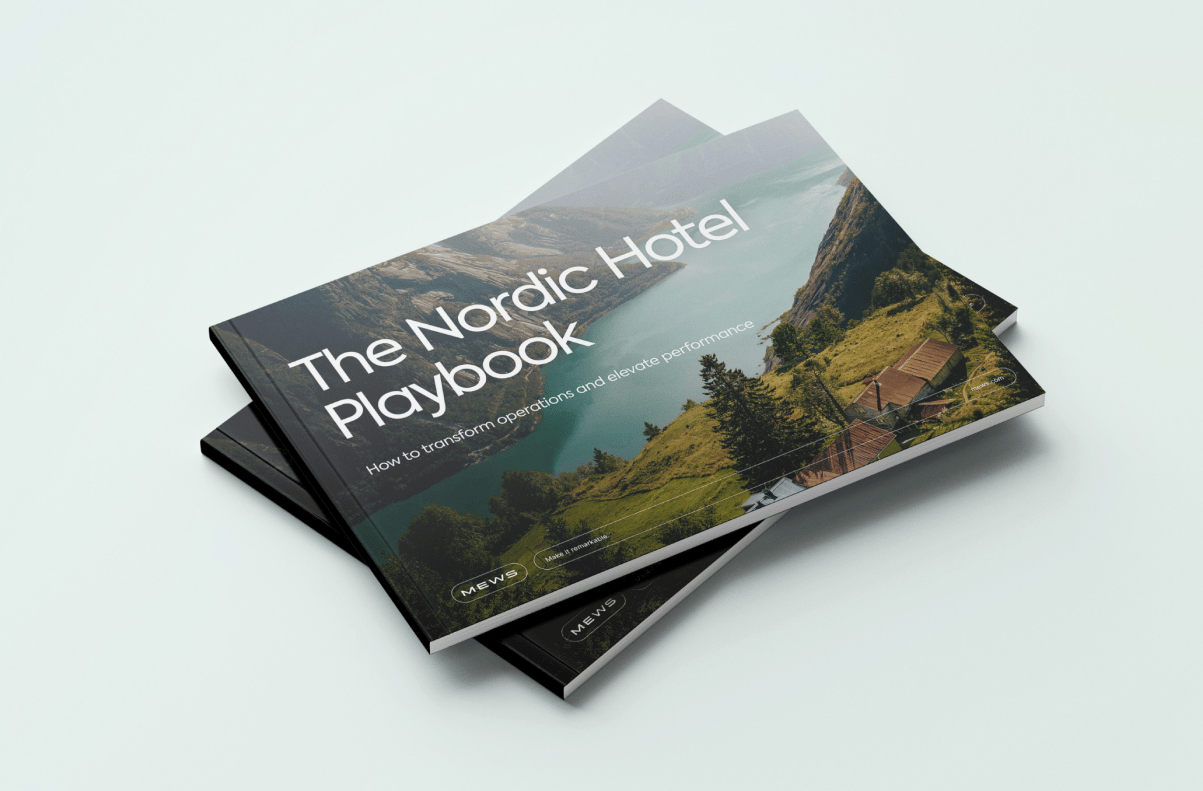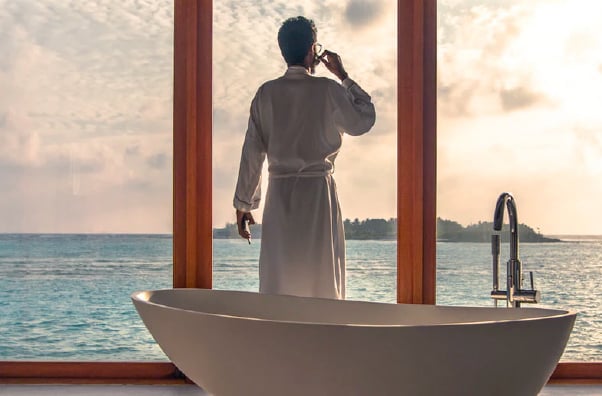Table of contents
Think of the last few orders from your favourite Mexican or Italian take-away. How often did you go for that extra guacamole, the dough balls or some other add-on you couldn’t resist?
Probably more often than you’d care to admit. (It’s ok, we won’t tell anyone).
Or think of airlines. You’ve probably paid for extra baggage or more legroom in the past.
Both of these scenarios are examples of upselling - someone offering you an add-on to improve your experience and drive ancillary revenue at the same time. While plenty of businesses use upselling to boost their top line, it’s still one of the most underused tools in hotels.
Many properties limit themselves to upselling only at the front desk during check-in. Unfortunately, that’s not the optimal time for it. It’s a stressful moment for the guest and your receptionist can’t promote too many offers at once. In short: this approach leaves ancillary revenue on the table and costs you chances to personalize your service.
However, when done right, upselling can boost both guest satisfaction and their lifetime value to your hotel. The key is offering the right upsell to the right guest at the right time.
Let’s look at how to do that.
How to take hotel upselling to the next level
A unique approach is necessary depending on your property and the type of guest you attract. A luxury resort welcoming spend-happy honeymooners will upsell differently from a downtown budget hotel targeting backpackers.
However, a few points are always important to consider.
1. Drive more direct bookings
Many booking engines don’t give you access to a guest’s email address, so you can’t send them pre-arrival upselling messages manually. Luckily, there are two ways around that: using an upselling platform that can reach OTA guests and driving more direct bookings via your hotel website.
Increasing direct bookings deserves a whole post of its own, but here are a few ideas to get you started:
- Deliver rich content that attracts your target audience: This can include targeted social media content that showcases your property’s benefits, as well as blog posts or videos that promote your destination and offer travel tips that your ideal guests want.
- Invest in your own booking platform: Add a fast, secure and straightforward booking engine to your website. The easier it is to book directly with you, the more people will go for it.
- Invest in your website, marketing and data: Once people reach your website, make it as easy as possible for them to find the information they need to book direct. That’s the only way to beat the industry’s average conversion rate of less than 2%.
Of course, for a great website to get results, you’ll need to get the word out about it via social media, ads or other marketing initiatives. Test different approaches, analyze your results and double down on what worked best for you.
Yes, all that takes an investment of time and money. But it’s more than worth it since direct bookings save you expensive commission payments and bring you closer to your guests.
2. Use the time between booking and arrival
This is a low-stress time because guests have made their key bookings (e.g. transportation, hotel) and the majority of research is done. Now, they’re full of anticipation and are eager to customise their stay experience by adding a few treats to their trip. This makes the pre-arrival period especially valuable because travelers are more receptive to extra offers.
You have two options to reach our guests pre-arrival:
- Manually message your guests: Send an email to every guest a few days before arrival and include a few offers for extra services or paid upgrades. This can boost your ancillary revenue, but it’s extremely time-consuming for your team. Only properties with low guest turnover (i.e. long average length of stay) may be able to handle this extra workload.
- Automate outreach with your PMS or upselling platform: This allows you to scale upselling (and your ancillary revenue) without creating extra work for your front office team. A smart hospitality cloud like Mews can automate pre-arrival upselling emails, or you can integrate with specialized upselling tools like Oaky that use smart learning to optimize upselling and maximize profits. If you want to take it a step further, you can even use such a platform to promote offers to in-house guests.
3. Make it simple and easy
Booking your upsell and cross-sell offers must be straightforward and quick for your guests. If it’s not, people will get frustrated or confused, and they won’t book. Of course, you also need to present your offers in a way that gets guests excited to book.
Follow these three tips to get on the right path:
- Make your offer clear: Use brief, engaging descriptions paired with appealing images to show what guests get when they book your offer. Descriptions should include all important details like inclusions, terms, or customization options. Photos work best if they feature people enjoying the service you’re promoting, or, in case of an upgrade, if they show the room from an angle that highlights its added value.
- Present your offer in an attractive way: Emphasise your offers’ benefits and value. This creates interest because it shows how well your extra services address travelers’ needs and desires. For example, when you’re promoting your airport pick-up, highlight the benefits of a quick, hassle-free transfer. Or if you’re offering a romantic dinner, paint a picture of unforgettable moments for two.
- Make it easy to book: Whether you’re pitching upsells via an automated upselling platform or emails you send out manually, the offers must be easy to book. The fewer clicks your guests need to take, the better your conversion rate will be. If the process is too long, more people will abandon it.
Know your guest - how to use segmentation for upselling in hotels
Know your guests so you can offer them the upsells and cross-sells they’re most likely to be interested in. Use your PMS data and guest communication to segment your guests and tailor the deals you pitch. This will make it more fun for them to browse and increase your conversion rates (and consequently your ancillary revenue).
Here’s some information to help customize your offers:
- Traveler’s age and birthdate: do you have a birthday deal or an activity popular with this age group?
- Reason for travel: are your guests traveling for a special occasion (e.g. their honeymoon)? Maybe you have a related package for them?
- Domestic vs. international: guests from your area may be more interested in off-the-beaten-path activities while international guests may want to focus on key attractions.
- Business vs. leisure: offer business travelers extra convenience (e.g. high-speed Wi-Fi, express check-in) and pitch leisure guests fun experiences to get to know the area better.
- Length of stay: how long are your guests staying? If it’s more than a few nights, a laundry package or a chance to exchange daily housekeeping for a free drink could work.
- Are they traveling solo, as a family, as a couple or with a group? Each of these segments has different needs and interests. Identify your main target segments and create tailored offers for them.
- How budget-conscious are your guests? Get an idea of your guests’ spending habits and create offers in line with them.
- Have your guests booked any other packages yet? Consider offering an add-on.
- Have they stayed with you before? If you know guests enjoyed your fine dining venue in the past, offer a related deal.
Find and analyze this information to know what could be most interesting and fun for your guests. Only pick a few suitable ones to pitch because too much choice can overwhelm people and results in them not booking at all.
Which hotel upsell deals to offer to increase ancillary revenue
The good thing about upselling is that you don’t have to reinvent the wheel. Start simple with room upgrades, early check-in and late check-out. Many guests expect these classic offers and book them frequently.
If you want to promote other departments too, go through the services you already offer to find the ones that would work well as a cross-sell offer. Look at what guests often book during their stay and consider bundling related services to create packages with added value.
Here are some ideas:
- Spa package: complete spa day including a steam, a scrub, a massage, a healthy lunch and a meditation session
- Restaurant package: set menu with wine pairing plus a tour of the kitchen
- Activity packages: what’s possible in your surroundings? A day of golf, sailing, hiking...?
Next, think about how you could repurpose some areas of your hotel and use them as part of an upsell. The idea is to make the most of what you already have and drive more ancillary revenue without major investment.
Some ideas for different guest segments:
- Couples: a romantic dinner with private butler service in your best suite
- Family: swimming lessons and art classes for kids, outdoor activities with a local guide
- Business travelers: high-speed Wi-Fi, parking, special add-ons for meals and room service
- Solo travelers: partner with local guides to offer activities solo travelers can join to meet others, host in-house movie nights, or curate walks in the area to boost the experience
- Loyal guests and VIPs: private dining at the Chef’s Table or a VIP tour of the wine cellar
Ways to boost ancillary revenue for non-staying guests
Focusing more on your local community will remain important to generate revenue as long as international travel lags behind previous years. Invite people living close to your property to explore your business and leisure services and create new offers with them in mind.
Look at your under-utilized areas and find ways you can offer them to non-staying guests:
- Lobby and meeting rooms: Set up co-working areas in your lobby or meeting rooms during slow periods. Share the details on social media, local news and platforms like Bizly or Spacebase to draw guests.
- Gardens: Host children’s birthdays and small garden parties or rent this space to photographers for photoshoots.
- Gym: Open your gym to the public during the off-season for people from your neighbourhood. Consider offering live yoga or workout classes and allow locals to join via apps like ClassPass.
- Restaurants: Attract more local guests to your restaurants with attractive seasonal menus, pick-up or delivery service. Taj Qmin did especially well with this during the pandemic.
Now that you’ve got some ideas on how to boost your ancillary revenue through upselling and engaging your local market, you’re good to go!
There’s one important thing to keep in mind though: your guests always come first. Creating a fantastic experience for travelers must be your priority. Offering deals and services guests love is a great way to do that. And when you get it right, you’ll see the positive impact on your guest satisfaction and your top line.

Author
Juliana Hahn
Juliana is a freelance copywriter for the travel and hospitality industry, drawling on practical hotel experience and studies.
Hospitality hot takes straight to your inbox
Sign up to our monthly newsletter for industry insights, product news, partner updates and more.

The Nordic Hotel Playbook
Download now


.webp)